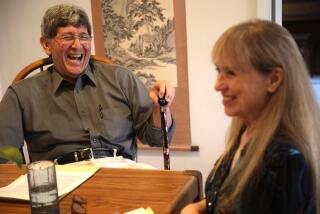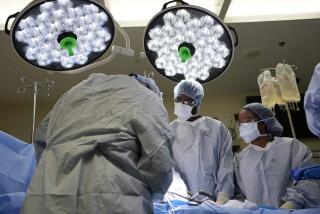Harvesting Hope of Survival : Patient’s Own Cells Are Collected and Used in Cancer Treatment
NEWPORT BEACH — Donna Uram’s ordeal began with a BB-size knot on her neck. For Mary Rhodes, it was a lump in the breast. And Carolyn Watley felt ill after walking up stairs.
All three were diagnosed with terminal cancer. For Uram and Rhodes the disease had originated in the breast, while in Watley’s case it had attacked the lymph nodes. Doctors gave them 12 to 20 months to live.
That was 2 1/2 years ago. But on Monday, the three women were honored at a special luncheon with smiles and tears, marking two years with no traces of cancer.
“I feel like a very special person,” said Rhodes, a 52-year-old bookkeeper from Tustin.
Doctors at Hoag Cancer Center attribute the trio’s survival to a special chemotherapy treatment.
It consists of bombarding cancer cells with drug doses more than 10 times stronger than usual. These doses would also kill healthy bone marrow, requiring a complete bone marrow transplant. But Hoag doctors harvest healthy cells from the patient’s marrow before the chemotherapy onslaught, freeze and store them and later reintroduce them to regenerate the marrow.
The technique, available at hospitals throughout the United States since the mid-1980s, allows high-dosage chemotherapy to be used on some patients who previously wouldn’t have been able to receive it.
“It’s new in medicine,” said Dr. Winston Ho, medical director of the bone marrow program at St. Joseph’s Hospital in Orange, which has been using the technique since 1990. “It’s on the cutting edge.”
Without the procedure, referred to by doctors as a “stem cell rescue,” the three Hoag patients would most certainly have died, according to Dr. Neil Barth, the medical oncologist who oversaw their treatment.
“I’m very excited about this,” Barth said. “I have a deep feeling of satisfaction.”
But the good news was very far away the day Rhodes learned that the lump she had discovered during a self-examination was malignant.
“To this day I don’t know how I got home from the hospital,” she recalled. “I knew that my chances were slim. I don’t think I had a well day in three months.”
Uram, a 54-year-old administrative assistant from Corona del Mar, said she felt like someone had kicked her in the stomach the day she was told she had cancer.
“First you do your crying,” she said, “and then you start fighting.”
And Watley, a 40-year-old insurance claims manager from Irvine, said it took her a long time to deal fully with the implications of the disease.
“You hear cancer, and you just go numb,” she said. “Automatically you think the worst.”
All three said that their emotional states improved considerably once the treatments began. For Watley, the chemotherapy was difficult, causing nausea and weakness. Uram, on the other hand, said it hardly fazed her. And Rhodes’ worst moment came not as a side effect of the chemotherapy but on the day that the program’s first patient, a woman she had befriended, died of the cancer.
“She was doing so well and then suddenly she was gone,” the former patient recalled, with the pain of the memory etched in her face.
In fact, Rhodes herself is the only survivor among the program’s initial 12 patients, all of whom started the therapy together in 1989.
Hospital officials said they planned Monday’s luncheon because the three women are the first to “graduate” from the hospital’s stem-cell program and survive for two years after going into complete remission. Of the 60 patients treated since 1989, Barth said, 55% are still alive. The survival rate after two years is about 40%.
That reality wasn’t lost on the three patients, who, accompanied by families and friends, ate salads and drank cider in a sunlit room on tables gaily decorated with bright yellow tablecloths.
“This has a lot of meaning,” Watley said. “You don’t realize how fortunate you are until you attend something like this. I feel like a miracle.”
Uram couldn’t have agreed more. “I’m happy to be here,” she said. “Life is a little more precious.”
Boosting the Power of Chemotherapy
Two major shortcomings of chemotherapy are that it kills healthy cells as well as cancer cells and that patients can withstand only limited treatment. But by harvesting stem cells from marrow and replacing them after chemotherapy, physicians are able to administer chemotherapy in higher, more effective dosages. Here’s how the harvesting treatment works:
1. Chemotherapy begun. This causes the body to produce more stem cells. These cells reproduce to make new oxygen-carrying red cells, infection-fighting white cells and platelets, which assist in clotting.
2. Blood cells filtered. Patient is linked to a blood-filtering machine, which harvests stem cells in a centrifuge, a 2 1/2-hour process. The cells are then frozen and stored.
3. Stronger chemotherapy. A higher dose of chemotherapy is administered, many times stronger than the first treatment.
4. Stem cells returned. After the chemotherapy drugs leave the bloodstream (usually three to five days), the patient is transfused with the previously harvested stem cells. Blood cell count recovers within two to three weeks instead of four to 12 weeks. Shorter recovery time reduces the risk of infection and bleeding.
Source: Hoag Hospital Cancer Center
Researched by JANICE L. JONES/Los Angeles Times






